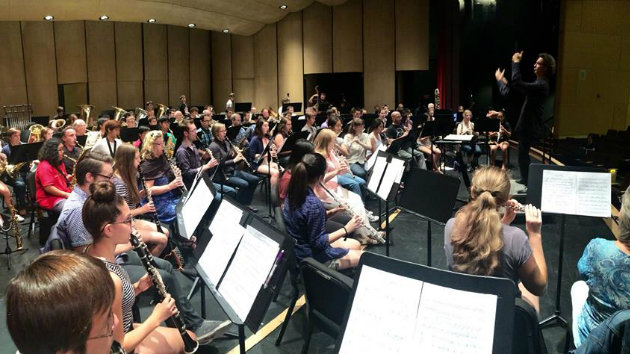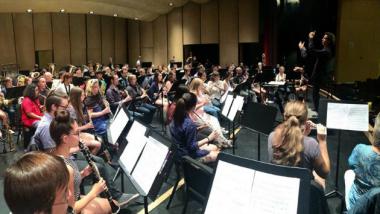
If you think performing arts programs in public schools lack ambition, you should meet Troy Davis and Martin Seggelke from Aragon High School and the San Francisco Wind Ensemble respectively. On Saturday, Nov. 7, at the school’s theater in San Mateo, Davis’ student musicians shared a concert with Seggelke’s professional performers. The evening culminated with the West Coast premiere of Thomas Trachsel’s third symphony, The Apocalyptic.
While the Swiss composer’s new work is substantial enough to be a concert in itself, Aragon’s three-hour concert was more epic than that: Both the Aragon wind ensemble and chamber orchestra performed. Davis conducts the former, and he is also an oboist in the professional wind ensemble. The student orchestra was joined by Gil Sullivan, an Australian pianist who performed a Mozart quartet and concerto with the students. He conducted the concerto from his piano, and the dexterity with which Sullivan simultaneously played solo and led a group of budding performers was impressive. The piece can best be described in terms of its monumentality — painted with broad brushstrokes and spread over a colossal scale, this work for a modern wind ensemble evokes a lush, late-Romantic symphony orchestra.
Trachsel (born 1972) is a composer, conductor, even publisher of wind band music. His massive, 70-minute work is in five movements. It is orchestrated for wind ensemble (consisting on Saturday of approximately 60 members) plus cello, double bass, harp, piano, and a children’s or women’s chorus. (Aragon’s women’s chorus filled that role for this concert).
The piece can best be described in terms of its monumentality — painted with broad brushstrokes and spread over a colossal scale, this work for a modern wind ensemble evokes a lush, late-Romantic symphony orchestra.
As its title suggests, the work also aspires conceptually toward the sublime. He writes, “The Apocalyptic stands for the threat coming from raging mental need.”
Trachsel commissioned a noted Swiss television journalist and author, Arthur Honegger, to write an introductory poem for the symphony. (As far as I can tell, he’s not related to the famous composer Arthur Honegger.) Seggelke read it in German before the performance, and the choir sang it throughout the last three movements.
If you consider the text in isolation, then the tone of the work would brighten as it unfolds. In the third and fourth movements, the young voices pose accusatory questions, including “Why is a small group abusing the treasures of this world?” and “Why are you doing everything to destroy the world?” In the final movement, by contrast, the youths are optimistic they can change the world for the better: “We will change it! We can do it.”
Taken in tandem with the music, though, a move toward optimism seems ambivalent at best. I could not make out actual sung words, so the innocent and ultimately hopeful voices were absorbed into prevailing somber music. The brass-heavy, ominous, first-movement theme recurs throughout all five movements. There were a few cracks during Saturday’s performance, which almost bolstered, rather than diminished, the work’s air of laboriousness. All five movements are grounded in minor keys, and even the scherzo could be described with an adjective the composer attaches to the last movement: Pesante.
The finale climaxes with a triple fugue using main themes from three of Trachsel’s symphonies. Given that the other two themes are intended to convey “Melancholy” and “Fear of our Time,” I did not exactly leave this performance with any raging mental needs assuaged or soothed. But the work’s refusal to suggest an unproblematic happy ending seems intentional, and is not, by itself, a negative.
Trachsel’s ambitions in this symphony come off as megalomaniacal, and his decadent, Romantic soundscapes sound a tad passé. But the pedagogical ambition of exposing high-school musicians to professionals such as Sullivan and SFWE is remarkable. Therefore — and while Trachsel’s symphony may have left me ambivalent — the program as a whole left me filled with hope.

